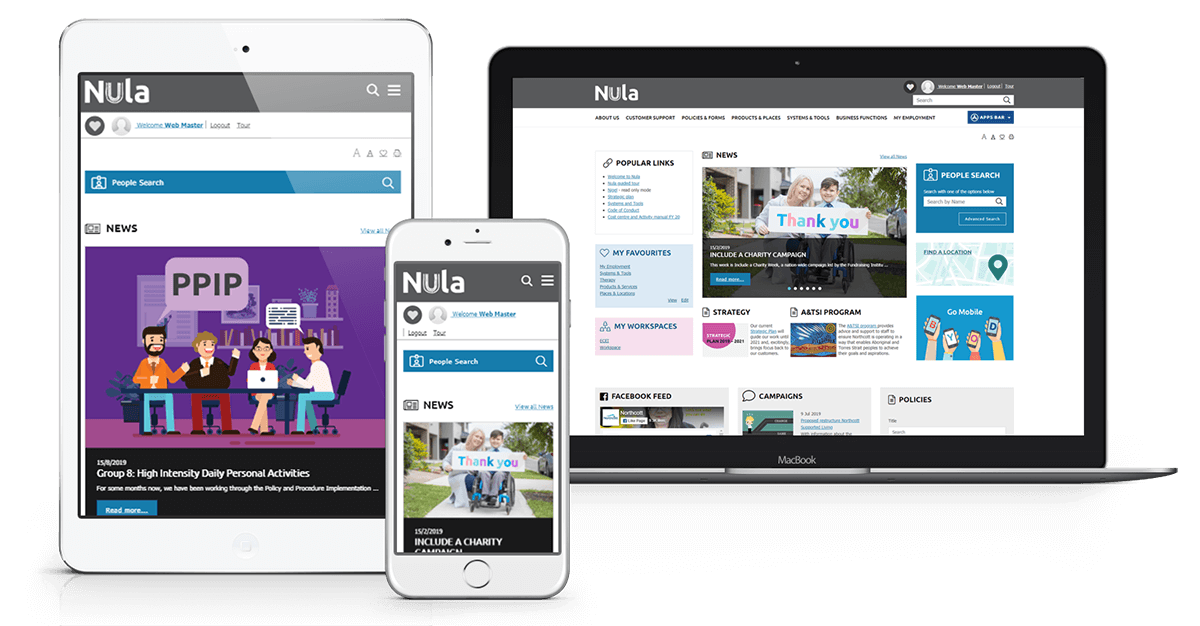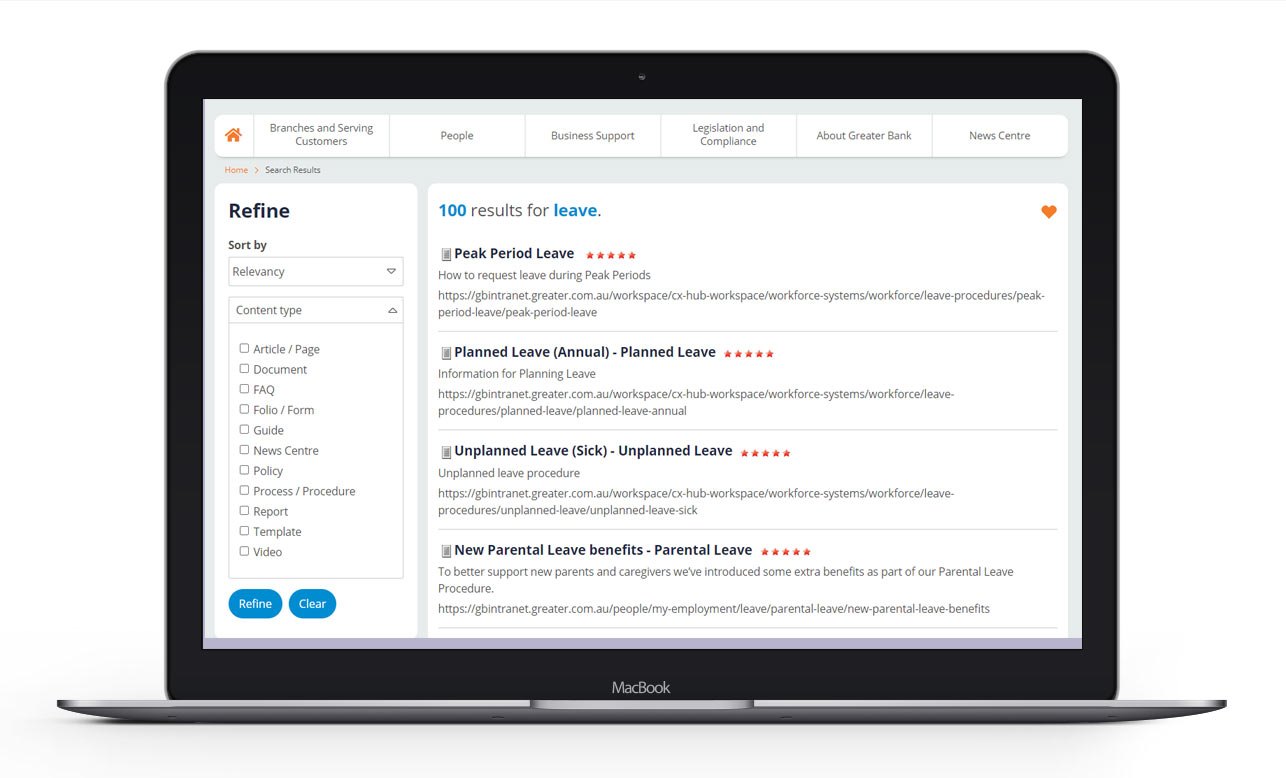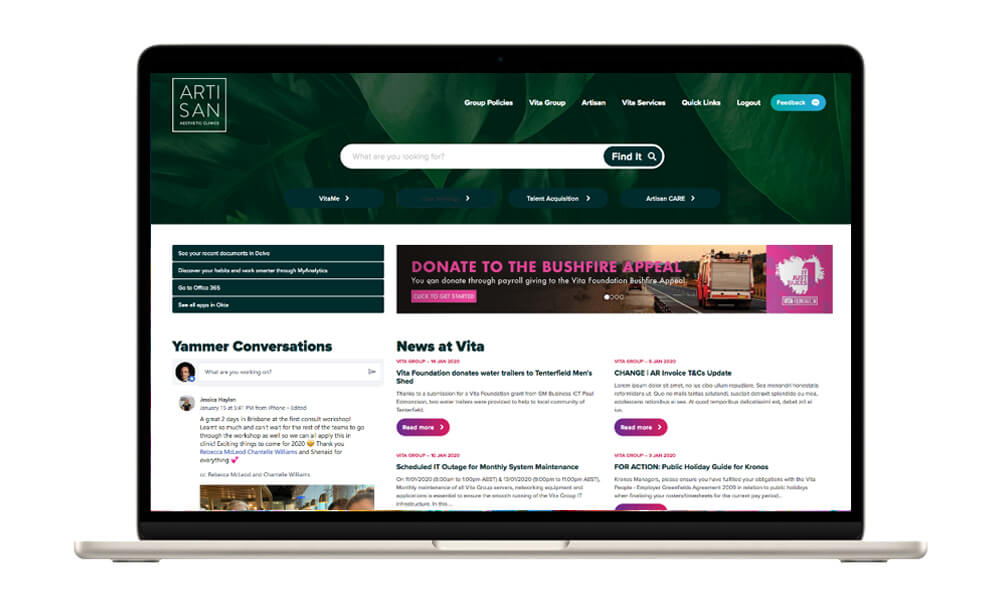Imagine the vast amount of knowledge and information your organisation generates every day. It's an ever-growing, dynamic database of facts, figures, insights, and ideas.
It’s the same for your intranet.
Without an effective search function, your intranet can quickly turn into a labyrinth, making it challenging for employees to find the information they need.
Let's delve into some of the intranet search best practices that will help you transform your intranet from a mere repository of data to a dynamic knowledge-sharing hub
Best Practices for Intranet Search
As organisations become larger and more geographically dispersed, the importance of effective internal communication cannot be understated.
The intranet, your digital home base for all internal communications, is the backbone of this communication strategy.
Search functionality is one of the important intranet processes you need to get right - a powerful tool that navigates through the maze of data, delivering the precise information you seek in a matter of seconds.
But how can we optimise our intranet search engine to ensure relevancy, accuracy, speed, and ease of use?
Relevancy: Hitting the Bullseye with Your Intranet Search
Optimising your intranet search function is not just about technology; it's about understanding the needs and habits of your users.
In the fast-paced corporate environment, every second count. Your team needs an intranet search engine that not only presents results but ensures those results are relevant to the search query.
This is where search relevance becomes paramount. It is about getting the right information to the right people at the right time.
One way to boost intranet search relevance is by applying metadata to your content. This helps the search engine understand the context of the content, thus delivering more personalised and relevant results. Another intranet search tip is to encourage the use of tags by employees. Tags act as shortcuts, guiding your search engine to the most relevant content.
Accuracy: Ensuring Pinpoint Precision
The key to improving the accuracy of your intranet search is to ensure the search engine is capable of comprehending different contexts, languages, and dialects.
It should be capable of recognising synonyms, handling misspellings, and understanding the nuances of natural language.
Taking advantage of automated search functions can greatly enhance accuracy of your intranet search results. Features such as predictive search, spell check, and natural language processing can interpret search intent, and deliver accurate results.
Speed: Ensuring Rapid Results
A key component of intranet search optimisation is speed. The modern-day employee values efficiency and speed, and a slow search can lead to frustration, reduced productivity and a decline in intranet usage.
Ensure it can handle large volumes of data without compromising on speed. Regular auditing and cleaning of your intranet's content can enhance the speed and efficiency of the search function.
Ease of Use: Keep It Simple
Last, but not least, your intranet search must be easy to use.
Improving intranet user experience can make the difference between a frequently used platform and a deserted legacy system.
It should offer an intuitive interface, responsive design, and user-friendly navigation. For example, a search bar that is visible and accessible from all pages on the intranet is a must.
With an increasingly remote and mobile workforce, the intranet search function should also be optimised for all devices to ensure seamless accessibility and use.
13 Essential Features for Intranet Search
So, now that you understand best practices, how to improve intranet search is the next question to answer.
Each of these 13 intranet search tips below aims to make the intranet search user-friendly and efficient. While it might take some time to implement and fine-tune these features, the improved productivity and user satisfaction make it worthwhile.
Note: Search is only one of the essential intranet features we recommend you implement. There are 10 key company features that are important.
1. Full-text Search: Going Beyond Keywords
Intranet search isn't just about locating documents or webpages; it's about understanding the context.
Full-text search is a powerful tool that allows users to search through the entire content of a document, not just its metadata or keywords. The ability to search for any phrase within the content further refines your intranet search engine's capabilities. It ensures that the search is comprehensive and provides results that are more aligned with the searcher's intent.
Imagine an employee trying to recall a specific segment from an annual report. The ability to use the intranet search to type the partial phrase into the search bar and find the exact document will save precious time and effort.
2. Advanced Search: Catering to Unique Search Needs
Not all searches are the same. Some are quick, basic look-ups, while others require more in-depth analysis. Advanced search capabilities cater to these unique search needs, providing users with an array of search options to precisely define their search criteria.
An effective intranet allows users to narrow down intranet search results. By using intranet search filters to refine results based on date, author, or category, users can find precisely what they are looking for without having to comb through countless irrelevant results.
Say a team member is looking for a marketing strategy from 2022; by using the advanced search, they can specify the date, department, and document type to narrow down results, quickly finding what they need without scrolling through irrelevant information.
3. Faceted Search: Multi-dimensional Searching
Faceted search is an innovative approach that allows users to apply multiple filters to their search queries. By doing so, they can drill down into the search results, making the search process more interactive and tailored to their needs.
For instance, if a new employee wants to understand your company's culture, they can filter content by 'culture', 'blog posts', 'newest first' - this way, they can read the latest discussions around company culture, rather than wading through outdated or irrelevant documents.
4. Federated Search: The Power of Integration
Federated search allows users to search across multiple databases or systems simultaneously. By consolidating the search results from different sources, federated search ensures comprehensive coverage and offers users a single point of access to all relevant information.
Consider an organisation that uses separate platforms for project management, HR, and operations. A federated search allows employees to search for 'leave policy' and get results from all platforms in one go, preventing the need to switch between systems and making information retrieval quicker and more efficient.
5. Best Bets: Handpicked Results for Common Searches
Best bets are manually curated search results that appear at the top of the search result page for common or critical search queries. By showcasing these "best bets," organisations can guide users towards authoritative and reliable sources of information.
Best bets are akin to staff recommendations in a bookstore. If 'onboarding process' is a common search, you can curate a list of essential reads, like onboarding checklists or introduction videos, and pin them as 'best bets'. New employees will appreciate the guided navigation and find their feet quicker.
6. Document Metadata: The Invisible Guide
The use of document metadata – information about the document rather than the content itself – can greatly enhance the accuracy and relevance of search results. By indexing document metadata, the search engine can better understand the context of the content, thereby delivering more personalised and relevant results.
For example, by adding details such as author, department, and date to a 'Marketing Strategy' document, your search engine can offer refined results based on these parameters, making it easier for staff to locate specific documents.
7. Relevancy Ranking: The Power of Prioritisation
Relevancy ranking is the art of prioritising search results so that the most pertinent information comes up first. By ensuring that your intranet search displays the most relevant results first, you can enhance user experience and improve productivity.
For instance, if an employee searches for 'annual report', the most recent annual report or the one most frequently accessed should be listed first.
To improve relevancy ranking, regularly analyse search logs to identify popular terms or phrases. Refine your search algorithm to bring these frequently searched topics to the top of the results list. For example, if 'leave policy' is a common search term within your organisation, ensure that the most current leave policy document is the first result displayed.
8. Intranet Search Personalisation: Making Relevance Personal
Intranet search personalisation is another best practice that can dramatically improve your intranet search experience.
Leveraging user profiles to customise search results can turn your intranet into a highly efficient, personalised information resource.
For personalisation, make use of security permissions. This will allow you to tailor content and features displayed by department, job role, location and other segments you want to use. So, when an HR manager in Sydney searches for 'team building activities', the intranet could prioritise results about HR-specific activities in Sydney, as it is most relevant to the user's role and location.
A good intranet will integrate with Active Directory or another third party system to pull new employees into the intranet and assign permissions and security groups to them automatically, as well as remove employees from the the intranet once they leave the organisation.
For more insights on intranet personalisation, watch the on-demand recording of the webinar 'Mastering Intranet Personalisation & Engagement'.

9. Autocomplete: Guiding the Search Journey
We often start a search without knowing the exact term or phrase we're looking for.
Autocomplete serves as a helpful guide, suggesting possible search terms as users start typing. This feature is invaluable in an intranet setting, where users may not know the exact title of a document but remember key terms or phrases from it.
Implementing autocomplete requires a solid understanding of the most common search terms within your organisation.
Monitor search trends and regularly update the autocomplete database with these terms, so when a user begins typing 'financial', they're promptly suggested with 'financial report', 'financial year-end', etc., saving time and reducing the potential for typos.
10. Intranet Search Analytics: Optimise and Improve
Keeping an eye on your intranet search analytics is essential for understanding user behaviour, identifying areas for improvement, and tracking the impact of the changes you make. Look for patterns such as frequently used search terms, common misspellings, and searches that return zero results. These insights can help you refine your search features, update your autocomplete suggestions, and improve your content to meet user needs better.
For instance, if a considerable number of searches are coming up empty, it might indicate a gap in your intranet content. If a specific document is frequently accessed but hard to locate, consider promoting it to a 'best bet'.
11. Instant Results: Every Second Counts
In today's fast-paced corporate world, speed is critical. Instant results — displaying potential search results as users type their query — can dramatically reduce the time it takes to locate information.
Instant results demand a fine balance between speed and accuracy. While designing the system, consider prefetching and caching popular search results. So, when a user starts typing 'employee wellbeing', the search engine instantly displays popular resources like 'employee wellbeing program' or 'wellbeing support services', as these terms have been prefetched.
It's worth noting that while this feature can greatly improve user experience, it should be implemented carefully, keeping in mind the load time and server resources.
12. Integration with Other Apps: Creating a Unified Search Experience
In the modern workplace, employees often use a variety of apps for different tasks, like email, document management, and project management. Integrating your intranet search with these apps can provide a unified search experience. For example, a search for a specific project name could bring up related emails, project files, and relevant intranet articles, all in one go.
Start with an inventory of all apps your staff use daily. The next step is to use APIs or develop custom connectors to ensure that your intranet search engine can access and index data from these apps. This way, when a user types 'Project X', they get emails about Project X from the email app, project files from the project management app, and any related documents within the intranet.
13. Crowdsourcing: Harnessing Collective Wisdom
Finally, consider harnessing the power of crowdsourcing to improve your intranet search. Users could add metadata to search results or upvote the relevance of search results, helping refine the search algorithm. It's about turning your intranet into a living, breathing entity that learns and grows with the collective wisdom of your organisation.
Create a simple, intuitive system where users can add tags to documents, enhancing the metadata. You could also include a voting system to rate the relevance of search results. For instance, after a user searches for 'work from home policy', they can upvote the most relevant result, helping the system understand which documents are the most useful for this term.
Real-world Examples
Now that you know the best practices and essential features of a great intranet search, here are examples of organisations that have implemented successful intranet search for their workforce.
Northcott: Facilitating a More Inclusive Environment

Northcott, a not-for-profit disability service provider, leveraged Elcom's intranet solution to create a more inclusive digital workspace. By implementing personalised search based on user profiles, Northcott ensured that employees could quickly find the most relevant resources, helping them to better serve their customers.
Greater Bank: Boosting Productivity with a Unified Search

At Greater Bank, the intranet search was optimised to integrate with their document management system. This ensured that employees could find information without needing to switch between platforms. As a result, it greatly improved productivity and reduced the time employees spent searching for information.
Vita Group: Harnessing the Power of Crowd Wisdom

Vita Group, a leading provider of communication products, took an innovative approach to intranet search by enabling employees to rate and comment on content. This form of crowdsourcing helped to improve the relevance of search results over time and made the search engine more intuitive.
These examples illustrate the transformative power of a well-optimised intranet search. By understanding your users' needs and continually refining your search based on their behaviour and feedback, you can create an intranet that not only improves productivity but also fosters a more collaborative and engaged workplace.
Give Your Employees What They Need to Succeed
Implementing these intranet search best practices can transform your intranet from a mere information repository to an intuitive, highly efficient knowledge hub.
With these features in your intranet search arsenal, your intranet will be more than just a communication tool; it'll be a dynamic, intuitive, and powerful knowledge-sharing platform that fosters collaboration and enhances productivity.
Remember, the key to an effective intranet search lies not just in the technology but in understanding and catering to the needs of your users. The ultimate goal is to make finding information as effortless as possible for your users!
If you're interested in more insights into delivering a successful intranet, check out our on-demand recording of the webinar 'Intranet Strategy: A Roadmap for Success'.
